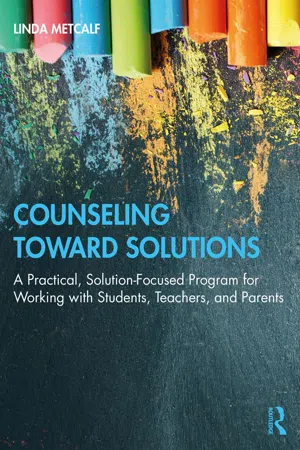When I first met Nate, two weeks into the new school year, I saw a very anxious 15-year-old who was refusing to attend school. His father, a single parent, accompanied him to the session and was very concerned about Nate’s school attendance. While I never ask why a client comes to counseling, Nate’s father was so distraught that he blurted out his concerns immediately and talked nonstop for 20 minutes about many factors that he believed had caused his son to refuse going to school. He had a lot of theories: his job, Nate’s mother’s departure, social media, and more. He was desperately concerned that Nate’s anxiety kept him not only from school but from having friends and getting out of the house. After listening to Nate’s father, I thanked him for the information and asked them both what their best hopes were for the session:
Go Slow to Be Brief
When school clients (students, teachers or parents) come into my office as distressed as Nate and his father, it is important at first to allow the school clients to feel heard. It has been my experience that sometimes school clients seem to need some time to talk about their concerns and recognize how the issue that brought them to therapy has intruded in their lives. This new addition to my solution-focused work is from narrative therapy, created by White and Epston (1990). Its addition seems to add a rich dialogue to conversations, especially when school clients are upset and not open to talking about a preferred future, yet. This addition to the approach, which I now refer to as solution-focused narrative therapy (Metcalf, 2017) also helps the school client to get a new view of the problem … that it is not he who is the problem … the problem is the problem. This is referred to as externalizing the problem, which allows the school client to step back and away from the issue, examine it and create a plan of action to defeat it.
So, together, Nate and I talked about the ways that the anxiety was robbing him of his desire to go to school. I made a long list which included the following:
The Anxiety:
1 Kept him from attending school
2 Robbed him of friends
3 Made him sleep too much at home
4 Kept him from talking to his father
5 Made him behind in his schoolwork
6 Isolated him
7 Made him feel badly about himself
8 Upset his father
Once the list was composed, I asked what their best hopes were, and the father said that his best hope was that Nate would attend school. Nate wanted the anxiety to stop happening. I then asked about times when Nate was able to stand up to the anxiety and go to school:
| Nate: | During elementary school it was better. I was a little anxious, but the teachers took time with me and things weren’t so busy in the hallways. That’s really what makes me anxious. Once I got into a routine, it got better, and I made it through the year. Seventh grade was okay too. This year, I did go to the new school for two days. |
| LM: | Really? How did you make it those two days? |
| Nate: | There is this coach. He teaches history and he’s really, really interesting. I like his class. My English class was okay too. It’s at the end of a hallway and it’s quiet down the hallway. Not many kids. She’s really nice. She just lets us come in and start reading so that’s good. |
| Father: | I agree that elementary school was better. He can be a little shy sometimes but once he warms up to people he does well. I think I was different then too, because I made him go. His mother had just left us, and Nate had to go to school because I didn’t have the flexible job I have now to homeschool him. I’m glad to hear that there are two classes that he likes. |
I asked Nate to scale where he was in regard to the anxiety, taking him over when he came in that day, using a scale of 1–10, with a 10 meaning anxiety was completely taking him over. He replied that the anxiety was at a 9. I asked how our conversation had possibly helped to lower the anxiety. He said it was then about an 8. We then discussed how he could go to school the next day and continue to stand up to the anxiety. He discussed taking breaks in the classroom, which were already set up by the school counselor. His father said he could be more insistent with Nate in the morning.
The next day, which was a Friday, I called to check to see how things had gone. His father answered and said things did not go well that morning. Nate refused to get up and get in the car. I then suggested that we try to meet on Monday with Nate’s teachers, early, before the classes began. I asked Nate’s father to call the school and arrange a meeting for all of Nate’s teachers, his school counselor and principal to meet for 20–30 minutes. I then asked his father to tell Nate that he only needed to go to school on Monday for a short time, for the meeting.
A Solution-Focused Conversation for School Refusal
The meeting on Monday was initially challenging for Nate. He did come into the school with his father, reluctantly, but when I approached him, he was physically trembling. He said he hoped he did not throw up in the meeting. I assured him that I would not ask much of him in the meeting and that I only wanted him to listen.
My plan for the meeting was to use a solution-focused conversation process consisting of three steps:
1 Identify the best hopes of everyone present, including Nate, his parent, teacher and administrator.
2 Develop together a preferred future, described by Nate’s teachers, parent and Nate.
3 Discuss exceptions with the teachers, or, times when Nate seemed more comfortable in school.
When I greeted the teachers, I thanked them for their time and said that I had permission to talk to them about Nate and began by saying that I was interested in what their best hopes were for Nate. Even though they had only had him in their classes twice, I always like beginning conversations such as these with this viewpoint. It immediately takes us to destination building, which is essential in the solution-focused approach. Talking about the problems takes things sideways and often backwards. Talking about where we want to go propels us all forward with a clearer mindset toward building solutions together.
Nate was not in the room at that point. Often, when I make school visits for my school clients, I meet teachers first, to give me a sense of where they are with a student. Some students may have been disrespectful to teachers, and I always want to give teachers time to vent if needed and discuss what they would like to see happen. In other words, they become my school clients too. I wait until I sense that the conversation can become solution building, which includes what the teachers need as well as the student. Sometimes, it takes a while longer, but since the student comes in toward the middle of the meeting, it is essential to set the climate up in a solution-focused manner.
Fortunately, Nate’s teachers responded to my initial question of “What are your best hopes for Nate?” well. They were quite positive in their remarks. I noticed though, that the coach spoke more. He described Nate as a student who seemed to be interested in his class which was a plus for him as a teacher. He said he liked Nate and noticed that he was sometimes nervous. At this point, with everyone having their turn to talk, I invited Nate into the meeting with his father. Nate was nervous.
At that point, I again asked the teachers to start off with their best hopes and impressions of Nate, which included helping him feel comfortable in class. Several of them were very friendly and supportive. The coach said “Hey, you know, I am always in the hallway keeping things running smoothly. If you ever need to talk or just hang out with me, no worries! Just walk up to me.”
Next, the English teacher spoke up and said, “I usually see you fairly calm in my classroom. You are always polite and get right into your reading. I think my class being at the end of the hallway is helpful to you, right?” Nate nodded. “I thought so. I like a calm classroom too,” she said.
As the meeting continued, some of the other teachers jumped in with things such as: “I eat lunch in my classroom each day; you are welcome to join me. My son once had similar concerns, so I get it!” The school counselor suggested that anytime he felt anxious he could certainly come to her office to sit on her couch and hangout until he felt ...


